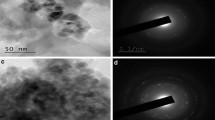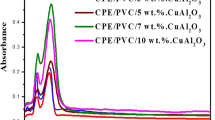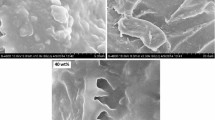Abstract
Novel nanocomposites based on poly(vinyl cinnamate) (PVCin)/zinc oxide (ZnO) were prepared by in situ polymerization method using different mass percentages of ZnO nanoparticles. The formation of nanoparticles in the composites was analysed by TEM, FESEM, XRD, DSC and TG measurements. The TEM and SEM images showed the uniform dispersion of nanoparticles within PVCin matrix. The results of XRD indicated that the metal oxide particles had entered into macromolecular chain of PVCin. The glass transition temperature of the composites was shifted towards higher temperature with the increase in concentration of ZnO nanoparticles. Thermal stability studies showed a remarkable increase in thermal resistance of composites, and the thermal stability increases with an increase in concentration of metal oxide particles. The alternate current (AC) electrical conductivity of prepared composite has been investigated at different temperature at various frequencies. The electrical conductivity was found to be increased with increasing temperature, and it obeys power law. The activation energy was determined from the AC conductivity. DC conductivity of all the composites was much higher than pure PVCin, and the conductivity increases with increase in the concentration of nanoparticles up to 7 mass% and thereafter the conductivity decreases with further addition particles. The experimental conductivity of nanocomposite was compared with different theoretical conductivity using Scarbrick, Bueche and McCullough equation. The conductivity values obtained from McCullough model showed the same trend as experimentally determined conductivity values.













Similar content being viewed by others
References
Ramezanzadeh B, Attar MM, Farzam M. Effect of ZnO nanoparticles on the thermal and mechanical properties of epoxy-based nanocomposite. J Therm Anal Calorim. 2011;103:731–9.
Janowska G, Mikolajczyk T, Olejnik M. Thermal properties and flammability of fibres made from polyimidoamide nanocomposite. J Therm Anal Calorim. 2007;88:843–9.
Stefanescu O, Vlase G, Barbu M, Stefanescu M. Preparation of CuFe2O4/SiO2 nanocomposite starting from Cu(II)–Fe(III) carboxylates embedded in hybrid silica gels. J Therm Anal Calorim. 2013;113:1245–53.
Mojumdar SC, Raki L. Preparation, thermal, spectral and microscopic studies of calcium silicate hydrate–poly(acrylic acid) nanocomposite materials. J Therm Anal Calorim. 2006;85:99–105.
Jayakrishnan P, Ramesan MT. Studies on the effect of magnetite nanoparticles on magnetic, mechanical, thermal, temperature dependent electrical resistivity and DC conductivity modeling of poly(vinyl alcohol-co-acrylic acid)/Fe3O4 nanocomposites. Mater Chem Phys. 2017;186:513–22.
Tjong S, Liang G. Electrical properties of low-density polyethylene/multiwalled carbon nanotube nanocomposites. Mater Chem Phys. 2006;100:1–5.
Erceg M, Kresic I, Jakic M, Andricic B. Kinetic analysis of poly(ethylene oxide)/lithium montmorillonite nanocomposites. J Therm Anal Calorim. 2017;127:789–97.
Wu SY, Tong X, Nie CD, Peng DQ, Gong SG, Wang ZQ. The effects of various carbon nanofillers on the thermal properties of paraffin for energy storage applications. J Therm Anal Calorim. 2016;124:181–8.
Liufu SC, Xiao HN, Li YP. Thermal analysis and degradation mechanism of polyacrylate/Zno nanocomposites. Polym Degrad Stab. 2005;87:103–10.
Ramesan MT. Fabrication characterization and properties of poly(ethylene-co-vinyl acetate)/magnetite nanocomposites. J Appl Polym Sci. 2014;131:3681–9.
Xiong HM, Zhao X, Chen JS. New polymer–inorganic composites: PEO–ZnO and PEO–Zno–LiClO4 films. J Phys Chem B. 2001;105:10169–74.
Qi Y, Zhang J, Qiu S, Sun L, Xu F, Zhu M, Ouyang L, Sun D. Thermal stability, decomposition and glass transition behavior of PANI/NiO composites. J Therm Anal Calorim. 2009;98:533–7.
Tang E, Cheng G, Pang X, Ma X, Xing F. Synthesis of nano-Zno/poly(methyl mathacrylate composite microsphere through emulsion polymerization and its UV-shielding property. Colloid Polym Sci. 2006;284:422–8.
Ahmed J, Arfat YA, Aguirre CE, Auras R. Thermal properties of ZnO and bimetallic Ag–Cu alloy reinforced poly(lactic acid) nanocomposite films. J Therm Anal Calorim. 2016;125:205–14.
Xiong M, Gu G, You B, Wu L. Preparation and characterization of poly(styrene butyl acrylate) latex/nano-Zno nanocomposites. J Appl Polym Sci. 2003;90:1923–31.
Elashmawi I, Hakeem N, Marei L, Hanna F. Structure and performance of ZnO/PVC nanocomposites. Phys B. 2010;405:4163–9.
Kim J, Hong SM, Kwak S, Seo Y. Physical properties of nanocomposites prepared by in situ polymerization of high-density polyethylene on multiwalled carbon nanotubes. Phys Chem Chem Phys. 2009;11:10851–9.
Ramesan MT, Pradyumnan PP. Synthesis and electrical conductivity studies of poly(methyl methacrylate) in presence transition metal ions. AIP Conf Proc. 2011;1391:658–60.
Zoromba MS, Hosn NM. Synthesis of Fe2O3, Co3O4 and NiO nanoparticles by thermal decomposition of doped polyaniline precursors. J Therm Anal Calorim. 2015;119:605–11.
Ramesan MT. Poly(ethylene-co-vinyl acetate)/magnetite nanocomposites: interaction of some liquid fuels, thermal and oil resistance studies. Polym Polym Compos. 2015;23:85–92.
Suhailath K, Ramesan MT, Naufal B, Periyat P, Jasna VC, Jayakrishnan P. Synthesis, characterisation, flame, thermal and electrical properties of poly(n-butyl methacrylate)/titanium dioxide nanocomposites. Polym Bull. 2016;. doi:10.1007/s00289-016-1737-9.
Singh S, Srivastava P, Kapoor IPS, Singh G. Preparation, characterization, and catalytic activity of rare earth metal oxide nanoparticles. J Therm Anal Calorim. 2013;111:1073–82.
Ramesan MT. Synthesis, characterization and properties of new conducting polyaniline/copper sulphide nanocomposites. Polym Eng Sci. 2014;54:438–45.
Ramesan MT. Synthesis, characterization and conductivity studies of polypyrrole/copper sulfide nanocomposites. J Appl Polym Sci. 2013;128:1540–6.
Zabihi O, Khodabandeh A. Understanding of thermal/thermo-oxidative degradation kinetics of polythiophene nanoparticles. J Therm Anal Calorim. 2013;112:1507–13.
Jayakrishnan P, Pradyumnan PP, Ramesan MT. Thermal and electrical properties of polyindole/magnetite nanocomposites. Chemist. 2016;89:27–32.
Kim HT, Park JK. Thermal degradation of poly(vinyl cinnamate). Polym Bull. 1998;41:325–31.
Du H, Zhang J. The synthesis of poly(vinyl cinnamates) with light-induced shape fixity properties. Sens Actuators A. 2012;179:114–20.
Gaur MS, Indolia AP. Thermally stimulated dielectric properties of polyvinylidenefluoride–zinc oxide nanocomposites. J Therm Anal Calorim. 2011;103:977–85.
Jayakrishnan P, Ramesan MT. Synthesis, characterization, electrical conductivity and material properties of magnetite/polyindole/poly(vinyl Alcohol) blend nanocomposites. J Inorg Organomet Polym. 2017;27:323–33.
Ramesan MT, George A, Jayakrishnan P, Kalaprasad G. Role of pumice particles in the thermal, electrical and mechanical properties of poly(vinyl alcohol)/poly(vinyl pyrrolidone) composites. J Therm Anal Calorim. 2016;126:511–9.
Ramesan MT, Jayakrishnan P. Role of nickel oxide nanoparticles on magnetic, thermal and temperature dependent electrical conductivity of novel poly(vinyl cinnamate) based nanocomposites: applicability of different conductivity models. J Inorg Organomet Polym. 2017;27:143–53.
Ounaies Z, Park C, Wise KE, Siochi EJ, Harrison JS. Electrical properties of single wall carbon nanotube reinforced polyimide composites. Compos Sci Technol. 2003;63:1637–46.
Loiu C, Kenji O, Masato S, Shinnosuke M. Anisotropic conductivity-temperature characteristic of solution-cast poly(3-hexylthiophene) films. Synth Met. 2006;156:1362–7.
Gupta K, Chakaraborty G, Jana PC, Meikap AK. Direct current conductivity of polyaniline-cobalt chloride nanocomposite prepared by wet chemical. J Phys Sci. 2009;13:251–60.
Nihmath A, Ramesan MT. Development, characterization and conductivity studies of chlorinated EPDM. AIP Conf Proc. 2014;1620:353–9.
McCullough RL. Generalized combining rules for predicting transport properties of composite materials. Compos Sci Technol. 1985;22:3–21.
Bueche F. Electrical resistivity of conducting particles in an insulating matrix. J Appl Phys. 1972;43:4837–8.
Sohi NJS, Bhadra S, Khastgi D. The effect of different carbon fillers on the electrical conductivity of ethylene vinyl acetate copolymer-based composites and the applicability of different conductivity models. Carbon. 2011;49:1349–61.
Scarisbrick RM. Electrical conducting mixtures. J Phys D Appl Phys. 1973;6:2098–110.
Acknowledgements
The authors wish to thanks Prof. P. Pradeep, Department of Physics, NIT Calicut for providing necessary facilities in the department.
Author information
Authors and Affiliations
Corresponding author
Rights and permissions
About this article
Cite this article
Ramesan, M.T., Jayakrishnan, P., Sampreeth, T. et al. Temperature-dependent AC electrical conductivity, thermal stability and different DC conductivity modelling of novel poly(vinyl cinnamate)/zinc oxide nanocomposites. J Therm Anal Calorim 129, 135–145 (2017). https://doi.org/10.1007/s10973-017-6140-8
Received:
Accepted:
Published:
Issue Date:
DOI: https://doi.org/10.1007/s10973-017-6140-8




